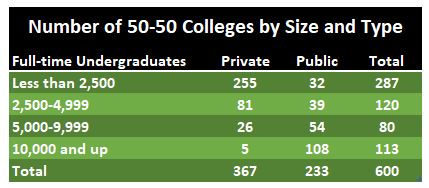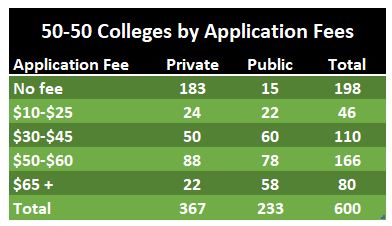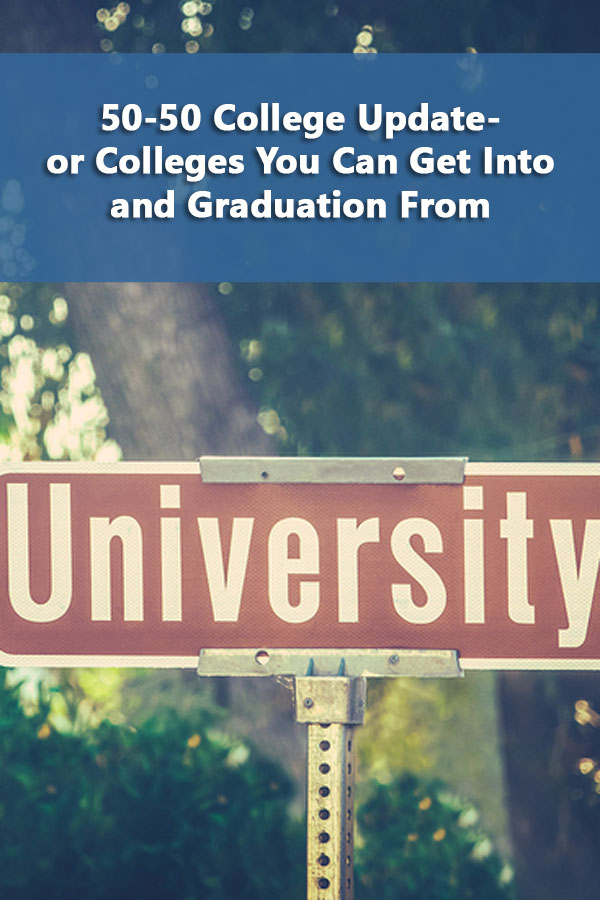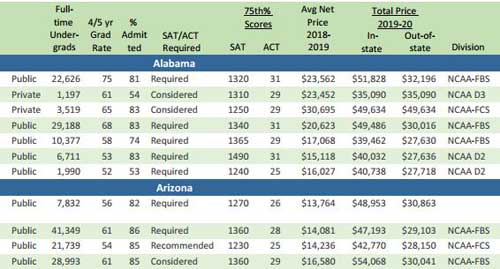 (Updated for 2022) I just finished updating the list of 50-50 colleges with the latest IPEDS data release and, as usual, thought I would share some statistically non-significant (as far as I know) observations. For those who don’t know what I mean by 50-50 colleges, these are colleges that accept at least 49% of students and have at least a 49% graduation rate. There are currently 600 such institutions with at least 500 or more full-time undergraduates up from the previous year’s 561.
(Updated for 2022) I just finished updating the list of 50-50 colleges with the latest IPEDS data release and, as usual, thought I would share some statistically non-significant (as far as I know) observations. For those who don’t know what I mean by 50-50 colleges, these are colleges that accept at least 49% of students and have at least a 49% graduation rate. There are currently 600 such institutions with at least 500 or more full-time undergraduates up from the previous year’s 561.
This is a significant improvement from when I first started the 50-50 list. At the time there were less than 400 schools on the list. If you include schools that accept less than 49%, you add another 128 colleges to the list. It’s still less than half of all four-year schools but there appears to be steady and meaningful improvement. It seems that colleges realize that it’s cheaper to keep a student in school than recruit a new one.
Click HERE to Download the List
More 50-50 Colleges in More States
Now for the interesting information I was talking about. Alaska is now the only state without a 50-50 school this year. The total number of private schools increased from 334 to 367 and the public from 227 to 233. 41% of all private colleges and a third of public institutions meet the 50-50 requirements.
There are 13 nine states where at least half of public universities are 50-50 schools. There are 18, down from 21 previously, states where 25% or fewer of public institutions qualify as 50-50 schools. This includes some states with a large number of public schools such as California, Texas, and Florida.
| 50-50 Colleges by State and Type | |||
| State | Private | Public | Total |
| Alabama | 2 | 5 | 7 |
| Arizona | 3 | 3 | |
| Arkansas | 4 | 1 | 5 |
| California | 21 | 11 | 32 |
| Colorado | 2 | 4 | 6 |
| Connecticut | 5 | 6 | 11 |
| Delaware | 1 | 1 | |
| District of Columbia | 1 | 1 | |
| Florida | 11 | 7 | 18 |
| Georgia | 6 | 2 | 8 |
| Hawaii | 1 | 1 | |
| Idaho | 2 | 2 | |
| Illinois | 19 | 5 | 24 |
| Indiana | 18 | 4 | 22 |
| Iowa | 16 | 3 | 19 |
| Kansas | 2 | 3 | 5 |
| Kentucky | 6 | 5 | 11 |
| Louisiana | 2 | 3 | 5 |
| Maine | 2 | 3 | 5 |
| Maryland | 8 | 5 | 13 |
| Massachusetts | 24 | 12 | 36 |
| Michigan | 8 | 7 | 15 |
| Minnesota | 13 | 7 | 20 |
| Mississippi | 1 | 2 | 3 |
| Missouri | 5 | 6 | 11 |
| Montana | 1 | 2 | 3 |
| Nebraska | 5 | 2 | 7 |
| Nevada | 1 | 1 | |
| New Hampshire | 2 | 4 | 6 |
| New Jersey | 8 | 10 | 18 |
| New Mexico | 2 | 2 | |
| New York | 37 | 20 | 57 |
| North Carolina | 5 | 6 | 11 |
| North Dakota | 3 | 3 | |
| Ohio | 21 | 7 | 28 |
| Oklahoma | 2 | 2 | 4 |
| Oregon | 6 | 2 | 8 |
| Pennsylvania | 46 | 14 | 60 |
| Rhode Island | 5 | 1 | 6 |
| South Carolina | 6 | 5 | 11 |
| South Dakota | 1 | 2 | 3 |
| Tennessee | 9 | 3 | 12 |
| Texas | 7 | 8 | 15 |
| Utah | 1 | 1 | 2 |
| Vermont | 4 | 2 | 6 |
| Virginia | 5 | 9 | 14 |
| Washington | 9 | 6 | 15 |
| West Virginia | 2 | 2 | |
| Wisconsin | 11 | 10 | 21 |
| Wyoming | 1 | 1 | |
Pennsylvania has the most 50-50 schools with 60 institutions, 46 private and 14 public. New York is second with 57 colleges followed by Massachusetts with 36. California and Ohio round out the top five with 32 and 28 each respectively making the list.
If you go by regions, the Mid East, which includes Pennsylvania and New York has the most 50- 50 schools with 150. The Great Lakes Region is next with 110 and the Southeast ranks third with 107.
Of the 39 schools that dropped from the list, all but 5 were because of a decrease in graduation rates. I added another 98 colleges that didn’t make the list last year.
Types of 50-50 Colleges
The various Carnegie Classification types of schools are generally well represented among the 50-50 schools. The largest group is the Masters level with 221 in the Masters categories. There are 204 in the Doctoral/Professional Universities categories with 72 falling into the high research activity group. The 147 Bachelor colleges includes 108 Liberal Arts Colleges and ten of those are public institutions.
Among this year’s 50-50 colleges, at least 292 offer full-ride scholarships including 120 public institutions. Of those, at 27 out-of-state students are eligible for some of the scholarships. A total of 43 are offering at least 10 or more National Merit Scholarships with three offering more than 100.
More Small Colleges than Larger Ones
There are a lot more smaller 50-50 colleges than larger ones. Over two thirds have 5,000 or fewer full-time undergraduates. Just under half are in the smallest category. The category with the lowest representation is the “Goldilocks” group.

This isn’t surprising since the same is true of colleges in general. I’ve brought this up before, if you want more college choices, you need to consider smaller schools.
Furthermore, if you want more affordable college choices, you should consider smaller schools. Among private 50-50 colleges, the smaller the school, the lower the average net cost.

The fact is that supply and demand exists in higher education. There are more smaller schools and they are less popular so they offer discounts.
Application Fees
Approximately a third of 50-50 schools did not have an application last year. Another 46 charged $25 or less to apply. However, over 40% had applications fees of $50 or more with 80 costing $65 or more to apply. 58 of the schools were public while there were only 22 private schools in this category. Over 90% of the schools without any application where private institutions.

Something else to keep in mind, over 500 of the colleges participate in the Yellow Ribbon program and 49 offer some sort of tuition guarantee plan. Furthermore, 50% or more of freshman without need receive merit aid at 242 schools that posted the information.
The complete 50-50 listing includes, size, graduation and acceptance rates, test scores, average net price, total costs, and application fees. You can get the information on all colleges in the DIY College Rankings Spreadsheet.



